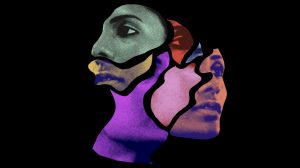When you hear the word “psychosis,” what springs to mind? If you are like most Americans, you see images of out-of-bound behaviors. Mad ravings about fantasy worlds full of aliens hell-bent on thought control. Vicious arguments with strangers about the presence of shadowy figures. Voices that speak in strange tongues and convey bizarre messages and irrational requests. Sudden, frightening, angry outbursts directed at complete strangers. In all cases, they are behaviors that are typically unwarranted and unexplainable. This is how the Western mind perceives and labels this phenomenon. It is a reductionistic, analytic approach to defining and quantifying behavior that is inexplicable and far removed from conventional reality. And, it is to be treated with antipsychotic medications.
To be fair, some people are able to regain some measure of control and avoid institutionalization, a horrible situation to be sure, by taking antipsychotic drugs, Though, even those that find relief from some of their most pressing issues are afflicted with a multitude of side effects, including tardive dyskinesia and impotency.
Still, there is something telling even in the name of the class of drugs. Antipsychotic means, against, or oppositional to the psychosis. From this perspective, the behaviors, the outward expression of being schizophrenic, is to be seen as the enemy, a parasitic infection to be rooted out and eliminated at all costs. But perhaps this is just one way of looking at it. Because other cultures that have a shamanic system of belief apprehend this phenomenon through a very different lens, one that takes into the totality of the spiritual dimensions that supersede our material plane of existence.
As Rebecca M. Rojas writes in the research article, Spiritual Sickness: A New Perspective and Approach to the Treatment of Psychosis, “Unlike modern psychiatry’s view on psychoticism as a condition with little to no recourse other than symptom management, societies with shamanistic spiritual beliefs rather equate a psychotic break to a fever, signaling not illness as an end-all but rather the beginning of a process, essentially spiritual growing pains.”
Seemingly esoteric, Rojas’ point is actually rather straightforward. We see mental illness through a culturally defined lens, which clouds our perception of more metaphysical forces at play. In the sacred text, Izinyanga Zokubula, another perspective is offered: “Do not give him any more medicines. Do you not see when you get uthlabo-medicines for him, the disease does not cease? When you give him medicine, do you not thereby increase the disease? Leave him alone. His people are in him. They wish him to dream.”
So, cultures informed by shamanic traditions see things differently, sometimes radically so.

Source: theswaddle.com
This sentiment is echoed by Dr. Tanya Marie Luhrmann, Watkins University Professor in the Stanford Anthropology Department, who states,“It’s quite possible that a clinician would say, well they have something like a story in the body, that looks like what I would call schizophrenia. In the interpretive religious wing, another domain, they might be seen as if they were possessed by demons or might be seen as prophets.”
In our Western medical roots there is an antithetical stance not just toward this disease, but in how we view the symptomology. Beyond something to be chemically exorcised from the brain, there is the sense that the outward behaviors are merely a distraction from the root cause, a massive biochemical imbalance, a deep perturbation of neurotransmitters. As Luhrmann frames it, “Psychiatric scientists used to think that these voices were just the side effects, the byproducts of the disorder, and you shouldn’t pay any attention to them. You know, they were unreal yet very painful to people, but they were just the byproducts of the disorder.”
Rojas points out how the shamanistic approach has parallels with Freudian and Jungian points of view, one that acknowledges the symbolic meaning underneath the behaviors, and ultimately seeks to elevate the afflicted to a healer of sorts. She observes, “This transformation of the patient to a healer is similar to the Jungian idea of the wounded healer. The shaman’s approach is congruent with psychodynamic theory, which asserts that strong feelings and emotions that are not dealt with consciously are repressed into the unconscious where they return to terrorize as inner demons.”
There is a similar process in the Catholic faith. Know as the Dark Night of the Soul, people’s fundamental underpinnings of faith are called into question in a profound, soul-searing manner, causing a visibly outward struggle that reflects the inward conflict.
Essentially, an existential transformation takes place as a person is forced to reidentify him or herself. As spiritual writer Joshua Press puts it: “The dark night of the soul is a stage in personal development when a person undergoes a difficult and significant transition to a deeper perception of life and their place in it. This enhanced awareness is accompanied by a painful shedding of previous conceptual frameworks such as an identity, relationship, career, habit or belief system that previously allowed them to construct meaning in their life.”
In the mid 16th century, the Spanish Mystic, San Juan de la Cruz (whose real name was Juan de Yepes and Álvarez), wrote the poem Noche Oscura, or Dark Night. In the poem, Cruz proclaims:
I lost myself,
I lay my face against my love,
Everything stopped,
My cares were left
Between the lilies, all forgotten.
The essence of Cruz’s messages is that after we face our inner demons, when we have walked across the lake of fire, when we have transcended our deepest fears and doubts, we will be reborn, purified, unencumbered by the layers of neurotic pretensions and outdated ways of thinking. This matches the shamanistic approach, which seeks to understand the internal struggles as a form of spiritual warfare that are expressed in their unique social context. Rojas argues, “The healer recognizes that the patient’s delusions and hallucinations are ‘condensed expressions of her social conflicts’ and as ‘increasingly desperate and unsuccessful attempts to resolve the social conflict of her domestic situation.’”
On a positive note, there are signs that this more spiritually oriented, psychodynamic approach to healing people with forms of psychosis is pushing its way into modern Western medicine. To begin with, the very fact that we are exploring the use of psychedelics to treat anxiety, depression, and PTSD, along with traumatic brain injury, is a nod to the inherent powers of entheogenic plants which are undergirded by the wisdom of indigenous cultures.
Emerging from these studies is an understanding of the complex web that interconnects culture, cognitive psychology, psychedelics, and metaphysical realities resting on an archetypal foundation.
In the article, The entropic brain: a theory of conscious states informed by neuroimaging research with psychedelic drugs, the authors contend, “The brain is inherited from its ancestors; it is the deposit of the psychic functioning of the whole human race. In the brain, the instincts are preformed, and so are the primordial images which have always been the basis of man’s thinking—the whole treasure-house of mythological motifs… Religious symbols have a distinctly “revelatory” character; they are usually spontaneous products of unconscious psychic activity… they have developed, plant-like, as natural manifestations of the human psyche.”
Moreover, Western practices are beginning to change as is it is increasingly informed by the concept that people exhibiting psychotics states as a result of schizophrenia have something valuable to teach us about themselves as individuals and about how we help them heal. Luhrmann explains, “There’s now a new movement in Europe called the Hearing Voices Movement (HVM), and what they do is that they teach people to respect their voices. They teach people with schizophrenia, paradoxically, to treat their voices as persons, to respect them as persons, and they find that some people are able to, in effect, persuade their voices to become more reasonable persons.”
Taking this approach allows clinicians to access the power of spirituality as a viable tool to treat and holistically heal people battling psychosis. Thus, using a shamanistic framework that encapsulates and respects the underlying psychospiritual conflict not only adds depth to treatment but simultaneously honors and elevates the patient. As Rojas, states,” Rather than viewing spirituality as a hindrance to science, it should be viewed as a means to an end. Incorporating the belief system of the patient, regardless of how bizarre, not only lowers the patient’s defenses against the clinician but may also provide a fecund environment for healing.”
One particular aspect that seems to stand out is how we help those battling with psychosis perceive and deal with the voices they may hear. The thinking goes that if you apprehend your voices as threatening and foreboding, your emotional state is compromised, further hindering you from integrating the voices into a more coherent, stable sense of reality.
The mediating component may be, however, the wider cultural elements that shape your perceptions. As Luhrmann elaborates, “. . . because there are cultural variations, that implies that the way that you listen to your voices will actually impact the way that you experience them, so that the American experience of feeling assaulted by these voices may actually be very costly for Americans who suffer from this disorder.”
However, we should not view this spiritual perspective as a simple fix to dealing with psychosis. Both the concept of psychosis as well as psycho-spiritual paths to healing are complex phenomena that demand rigorous research and constant revision in light of newly-gained knowledge. Moreover, that knowledge must be integrated into existing treatment models that are increasingly informed by our understanding of brain physiology. Seeing it as a magic bullet is at best naive, and at worst potentially dangerous to those seeking help.
To that end Lurhmann provides this caveat: “I don’t think it’s a panacea. I have met people who had spiritual interpretations that are voices, and those spirits told them to do terrible things, and then they did them, but I think to have a more spiritual understanding gives people a possibility of a little more control over the experience, paradoxically enough.”
Perhaps with the right balance of shamanic spirituality and Western therapeutic models, we can help those who are embroiled in the dark night of their soul as they wrestle to leave their cares “between the lilies all forgotten.”






